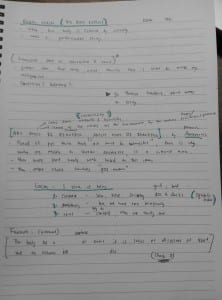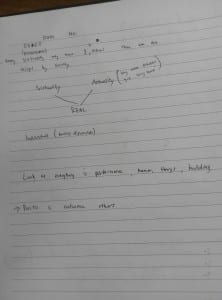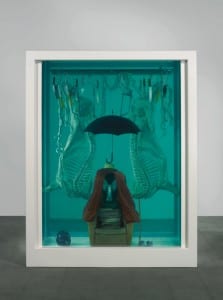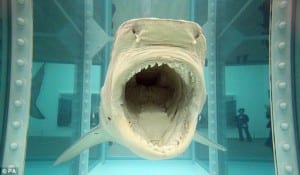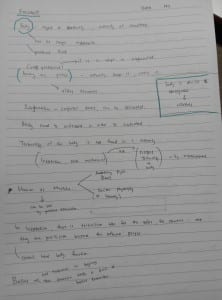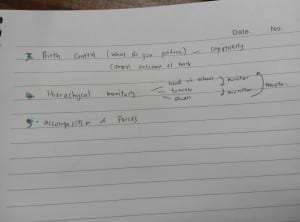BODY
- body as site.
- body itself is performative.
- is always already in presentation and representation.
- artist’s body as source material and expressive medium.
- in many forms of performance, body is employed or reemployed to expose norms by transgressing it.
BODY ART
– works that involve the artist’s enactment of her/his body in all of its sexual, racial, and other particularities.
LIVE ART
– challenge categories of practice of art & theatre. It is an aesthetic of the present moment, of here (space, place) and now (time), immediacy encounter.
– an event between artist & spectator, or maybe the artist create a situation and let the spectator experience the work in a specific place and time even without the present of the artist.
– body, time , space
– offers a means to critique cultural norms, fixed perceptions and sedimented values as they pertain body, identity n society.
– performer remakes identities and social relations.
ALIVE (live art)
- obsess with liveness (to be as real as possible, live element), to shock, to destroy pretence, to activate audience
- always using Shock Tactics.
- Lasting (visual art) and temporary, immediacy (live art).
TIME
- concept of TIME is important in live art performance, performance has consistently replaced or qualified material object with temporal act.
- contemporary live art experimentation with time – improvisation & chance, employing actions in real time and space, repetition, duration.
- live artists brings the spectator into the present moment of the making and unmaking of meaning, where you really have to be there.
- time itself is a product of structures of thought.
- live art works try to break the boundary of culture norms and challenge male gaze.
SPACE & PLACE
- I think that there is space in our body also, not only the outer space from our body. We can feel the space inside our body as well.
- In the text, there are resistance of rules and perceptions from live artists about the usage of space and place. For example, gallery has their own rules and regulations of the space. But live artist try to break the rules or choose to perform in unconventional place, like outside of the gallery.
- place is the product of certain rationales or ideologies that order its architecture, the habitual practices, social encounter that happen within it.
Franko B, I miss you.
In my point of view, this performance has break the boundary of performance. To me, the stage looks like a run way. He repeated walking back and forth just like the modelling show. But in fact, he changed the content of it. He shown his white painted naked body and his dripping blood in order to create shocking sensation to the audience and to send out certain meaning/message behind the performance.
This was a short teaser of Chi Too’s work. He is one of the artist from Malaysia but he created a slogan for himself: Can’t pain, can’t draw, can’t dance.
In this video, however it is short, but I can understand SPACE and at the same time I can see the involvement of the spectator and how important the role of SPECTATORSHIP.
Title: The Pursuit of Oblivion by Damien Hirst.
In the first page of ALIVE, Adrian Heathfield uses this artwork as the example. He mentioned that this work seems more about presentation of some phenomena than representation, where Damien Hirst used the original element or object to create art work but not to re-make the element to become ornament.
The art work also challenged the space between sculpture, installation and live art. Adrian found the work creates sense of shocking to the viewer. In his opinion, this work has made a shift in contemporary visual art where lasting become temporary and immediacy.
All these points are closely related and happened to Live Art as well.
Title: The Physical Impossibility of Death in the Mind of Someone Living by Damien Hirst.
– A shift to the live.
– with this picture I understand ‘liveness’ that mentioned in the text. The shark that is not alive looks so liveness.
BODY ART PERFORMING THE SUBJECT
Antonin Artaud,
“theater of cruelty,” an intense theatrical experience that combined elaborate props, magic tricks, special lighting, primitive gestures and articulations, and themes of rape, torture, and murder to shock the audience into confronting the base elements of life.
- Anti-feminism Feminism.
- challenging male gaze. In the text, the writer used Carolee Shneemann’s art work, Interior Scroll as example. Her exotic enactment of her body and sexuality were challenging the male gaze.
- destabilise conventional art, break the boundary.
- Voyeurism (sexual interest in or practice of spying on people engaged in intimate behaviour, private nature) often used in body art performances, sometime to challenge male gaze.
- In Yayoi Kusama’s performance, it shown the otherness with the normative conceptual of the artist as Euro-American male. She as an asian female performed in New York public places with her naked body.
About Dadaism:
- not a movement, its artists not artists and its art not art
- Dada had only one rule: Never follow any known rules.
- Dada was intended to provoke an emotional reaction from the viewer (typically shock or outrage).
- influence by Abstraction and Expressionism.
ART & POLITIC
- Link about Gustav Metzger (an artist who affected by politic and Nazi):
http://www.theguardian.com/artanddesign/2012/nov/26/gustav-metzger-null-object-robot
- about Joseph Beuys:
http://www.walkerart.org/archive/4/9C43FDAD069C47F36167.htm
- political art is art that produces a reverberating double effect, a heterology: ‘the readability of political signification…
- legible n illegible
ART & LIFE
- Jean-Jacque Lebel framed that happening as a mean of overcoming art, leaving theatre behind, arriving at life.
- Happening as the art of participation.
- example of works that showing what happen in the street as performance; juxtaposing the ‘staged’ with the ‘unstaged’.
BODY POLITIC
- Live art brings artist body into view in new ways, engaging questions of ownership.
- body reveals politics
- live art practices, where body is the material, take that already culturally marked body and remark it.
- ‘Embodied’ signified the materiality of body.
- many works related to feminism issue and also sometimes over patriarchy.
[I WAS PERMITTED TO BE AN IMAGE BUT NOT AN IMAGE-MAKER CREATING HER OWN SELF-IMAGE]
by Carolee Schnerrman 1979
- signifying body as a site of oppression – feminist history, women use body as medium and message
[Does women have intellectual authority while naked & speaking?] by Elwes 1985.
Ranciere – insists upon the emancipatory解放 act that is spectatorship, where one who looks is actively engaged in narrating and translating, story to make it her story (spectator is an active role).
- Street Action, necessity of resistance.
Minding the Matter of Representation: Staging the Body (Politic)
Basically explain and discuss about the performing art scene and history in West. Theatre, dance, live art and academic study in performing and visual art. Looking at the big picture of the society and politic and relates them with art and body.
- Social norm about the privilege ‘universal’ and the marginalise ‘other‘ (black, women, disable, gay, lesbian..) is so clear.
- Artuad – body-as-desiring-machine.
Manifesto宣言 on Liveness
According to Tim Etchells, real people in real time really pretending. The processes of transformation of costumes, props and sets and pretence are what the culture is made of and think of. Gets made and unmade.
In one of the letter, he written like this:
‘Why should we trust audience at all? I mean, who are these people.’
This make me think that why performers always try to give their best to the audience? just because they pay for the ticket? or just a respect? or to show off ourself ?
Audience always come to a show with certain expectation. But the question is do we have to satisfied the audience?
FOUCAULT
- in the text, Foucault explained that prison is a form used by discipline, prison’s body is being torture, punish and train to be discipline. Similar form can be found in today’s world such as in school, factory and military camp. He put the focus on the body and related with the question of power, which then related to society.
- trying to understand this: ”power and knowledge imply one another, as opposed to the common belief that knowledge exists independently of power relations (knowledge is always contextualized in a framework which makes it intelligible, so the humanizing discourse of psychiatry is an expression of the tactics of oppression).”
- Public torture/execution (is to fear the people, control them) has express his/her power, but it depended on the participation of the people.
- Discipline applied on body, and body is being used, transform, subjected and improve.
- Discipline has created new economy and politic on body. Body must function according to their tasks, training, observation and control. In this case, discipline has structured how the people should act in the society and created new politic and economy which remain until today.
- Discipline then created Docile Bodies. Bodies that follow rules, structures and orders like in school and military barracks. Docility is happening everywhere and almost every human being today.
- Foucault’s interested in how power turn human into subject (people who participant subjectification by exercises the power over themselves). He suggests refuse to be what we are or be the subject under the power of the government.
see also:
http://www.sparknotes.com/philosophy/disciplinepunish/section6.rhtml
ANSWER
1. Performance is an action, in order being, doing, showing doing and explaining ‘showing doing’. Human actions in the category of ritual, play, sports, popular entertainments, the performing arts & everyday life performances in social, gender, race, work, the internet and more.
As Performance – everything and anything can consider as performance. To perform as a student, a teacher, president, and etc.
Is Performance – where the intension is to perform.
2. Performance studies – study about performance. Synthesis综合 wide variety of disciplines including performing arts, social science, feminist studies, gender studies, cultural study and more.
– performance studies is open where there is no finality, it is flexible, allow to be explore and update. It was designed to answer the need to deal with the changing circumstances of the glocal (combination of local and global).
– Performance study embodies the values, theories, and practices which can apply in many fields. For art field, when you have the knowledge of performance studies, you understand and appreciate art work more.
– Richard Schechner, pioneer of performance studies. He is a scholar, a professor, theatre director, author and editor.
– Victor Turner, anthropologist. He developed the concept of Liminality. He studied ritual and social change.
QUESTIONS:
1. Confuse about the similarity of body art and live art. Can body art also call live art?
Index:
- spectatorship – viewer is involved and engaged in the viewing experience. http://tonymckibbin.com/course-notes/spectatorship-theory
- performativity – is everywhere, and almost everything depend on how you see it. For example how the macbook perform its ability and its function.

How my friend shown his hunger and desperate towards the food. It is very performative.
- alterity/otherness -Other and self are inherently joined and so when we ‘speak’ of otherness, we inevitably ‘speak’ of its other. It also refers to the divergent from what that is given.
- gender – is a performative act (one is not born as woman, but becomes a woman) by Judith Butler.
- scopophilia -sexual pleasure derived chiefly from watching others when they are naked or engaged in sexual activity.
- identification – Human understand the mirror stage as an identification: the transformation that takes place in the subject when he assumes an image.
- Fluxus – flowing,fluid. An international network for artists, composers, designers blending different media and discipline (Intermedia) in 1960s.
Augusto Boal – created the Theatre of the Oppressed which is a series of theatrical analyses and critiques developed in the 1950s.
Antonin Artuad – important figure of evolution of the modern drama theory. Theatre of Cruelty was his most noted drama theory.
Joseph Beuys – a German artist who active in diverse range of art forms.
Jacque Ranciere – French philosopher. His aesthetic theory has become references in visual art.
Jacque Lacan – a famous French structuralist psychoanalyst. His ideas have influenced on critical theory, feminist theory,sociology, clinic psychoanalysis and etc.
